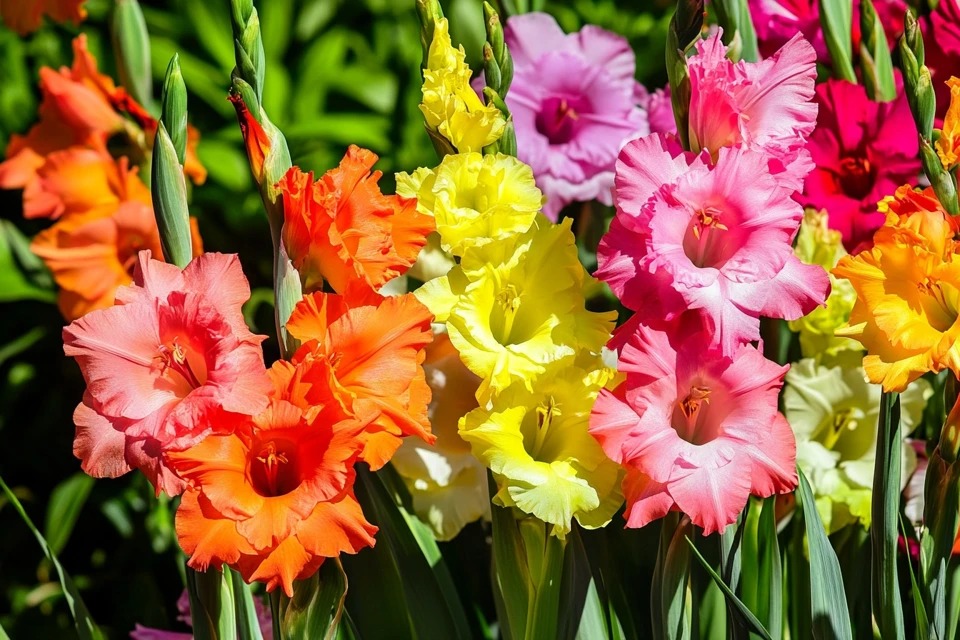
Often called the “sword lily,” the gladiolus stands tall in the summer garden, sending up impressive flower spikes that provide vibrant color and dramatic vertical interest. This classic flower is a favorite for good reason.
The Gladiolus (Gladiolus Hybrid) is treasured not only for its beauty in garden beds but also as a superb, long-lasting cut flower. This guide will walk you through everything you need to know, from planting the corms to creating your own stunning bouquets.
What is a Gladiolus? The Garden’s Sword of Color

The gladiolus grows not from a true bulb, but from a flattened, underground stem called a corm. Its name comes from its long, slender, sword-like leaves that create a bold, upright shape in the garden.
From the center of these leaves, a tall flower spike emerges, with individual flowers, or florets, arranged neatly up one side. These florets bloom in sequence from the bottom to the top. Historically, this beautiful flower has been a symbol of strength and integrity.
Understanding Gladiolus Types
While you might picture one classic look, the Gladiolus (Gladiolus Hybrid) comes in several types. The most popular are the large-flowered Grandiflorus hybrids. These are the tall, dramatic gladioli famous for their big, ruffled flowers packed onto impressive spikes.
You can also find smaller, more delicate options. Miniature hybrids and Primulinus types have shorter stems and smaller florets. They are an excellent choice for containers or smaller garden spaces and often require less staking than their towering cousins.
Planting Your Gladiolus for a Summer-Long Show
Getting your gladiolus corms in the ground correctly is the key to a spectacular summer display. With just a little planning, you can ensure you’ll have tall, healthy flower spikes that will brighten your garden for weeks.
Choosing the Best Corms and Planting Site

Your success starts with choosing good corms. At the garden center, look for corms that are large, firm, and plump, without any soft spots or signs of mold. Bigger, healthier corms will produce bigger, more impressive flower spikes.
Gladiolus plants need two main things to thrive: full sun and soil that drains well. Pick a spot in your garden that gets at least six to eight hours of direct sunlight each day. Good drainage is essential to prevent the corms from rotting in soggy soil.
How and When to Plant
The best time to plant your gladiolus corms is in the spring, after all danger of frost has passed and the soil has had a chance to warm up.
Plant the corms about 4 to 6 inches deep with the small, pointed side facing up. Give each corm enough room to grow by spacing them approximately 6 inches apart in the garden bed.
Pro Tip: Succession Planting
Do you want to enjoy gladiolus blooms all summer long? The professional secret is succession planting. Instead of planting all your corms at once, plant a new batch every two weeks from spring into early summer.
This simple trick staggers their bloom time. As one set of flowers begins to fade, the next set will be just starting to open, giving you a continuous supply of fresh, beautiful spikes for both your garden and your vases.
Essential Care for Healthy, Upright Gladiolus Spikes
Once your gladiolus plants are growing, a few simple care steps will ensure you get the best possible blooms. Proper watering, feeding, and support will keep those magnificent flower spikes standing tall and looking great.
Watering and Fertilizing
Gladiolus plants need about an inch of water per week, so make sure to water them deeply during dry spells. Consistent moisture helps them build strong stems and vibrant flowers.
When you first see the flower spikes starting to emerge from the leaves, it’s a good time to fertilize. Use a fertilizer that is low in nitrogen and high in phosphorus, such as one with a 5-10-10 ratio. This encourages big blooms instead of just leafy growth.
The Importance of Staking

Staking is one of the most important jobs when growing a Gladiolus (Gladiolus Hybrid). The tall flower spikes are heavy and can easily bend or break in strong wind or heavy rain.
You can place a single bamboo stake next to each plant and loosely tie the stem to it as it grows. If you’ve planted a large group, an easier method is to place stakes at the corners of the patch and run twine between them to create a support grid for the plants to grow through.
Harvesting for Stunning Bouquets
Gladiolus make incredible cut flowers that last for a week or more in a vase. The best time to cut a flower spike is in the morning when the bottom one to three florets have just opened.
Use a sharp knife to make a diagonal cut. Be sure to leave at least four leaves on the plant in the garden. These leaves will continue to gather sunlight to feed and grow the corm for next year’s show.
Overwintering: How to Save Your Gladiolus Corms
If you live in a colder climate (USDA Zone 7 or below), your gladiolus corms will not survive the winter in the ground. To enjoy them again next year, you will need to dig them up and store them indoors. This simple process is easy to do and well worth the effort.
Lifting and Curing
Wait until a few weeks after the first fall frost has turned the foliage yellow or brown. Carefully dig up the corms with a garden fork, being gentle not to damage them. Shake off the loose soil and cut the stalk off about an inch above the corm.
Lay the corms out in a single layer in a warm, dry, and airy location, like a garage or shed, for one to two weeks. This curing process helps them dry out properly for storage.
Storing for Next Season
After curing, your corms are ready for their winter rest. Gently brush off any remaining soil. You will see the new, plump corm has formed on top of the old, withered one. Twist off and discard the old corm from the bottom. You can also save the tiny new corms, called cormlets, to plant in the future.
Place the healthy, cured corms in a mesh bag, a paper bag, or a cardboard box with some peat moss. Store them in a cool, dark, and dry place until you are ready to plant them again next spring.
FAQ: Your Gladiolus (Gladiolus Hybrid) Questions Answered
Here are clear, direct answers to some of the most common questions gardeners have about growing these spectacular flowers.
What colors are gladiolus hybrids?
Gladiolus (Gladiolus Hybrid) varieties offer a breathtaking range of colors. You can find them in almost every shade imaginable, from the softest pastels to the most vibrant jewel tones, with the exception of true blue.
Look for pure white, sunny yellow, soft pink, fiery orange, deep scarlet red, and rich purple. Many modern hybrids are even bi-colored or have beautiful, intricate markings on their petals, making them truly eye-catching.
How long does it take for gladioli to multiply?
Gladiolus corms multiply each season. The main corm you plant will flower and then wither away, but a brand new corm will form on top of it for the next year. At the same time, it will produce several tiny baby corms called “cormlets.”
If you separate and plant these cormlets, they will grow into full-sized, flowering plants. However, it typically takes them about two to three years to become large enough to produce their own flower spike.
Do gladiolus spread by themselves?
No, gladiolus do not spread aggressively or become invasive in the garden. The clump of corms will get a little larger and more crowded in the same spot each year as new corms and cormlets form. They will not send out runners or pop up in different parts of your garden bed.
What not to plant next to gladiolus?
It is best to avoid planting gladiolus directly next to beans and peas, as these plants can release substances into the soil that may inhibit the growth of your gladioli.
You should also avoid planting them near other flowers that are particularly prone to the same pests and diseases, like thrips or fusarium wilt. Asters, for example, can be susceptible to fusarium and could pass it to your gladiolus.
Conclusion: The Rewarding Beauty of Gladiolus
The gladiolus is truly a star performer in the summer garden. Its value as a source of dramatic, vertical height is unmatched, and its long-lasting spikes make it a premier cut flower for bringing beauty indoors.
Remember to give them a sunny spot and provide support with simple staking to keep them standing tall. With just a little effort, any gardener can successfully grow and enjoy the spectacular, colorful display of the magnificent “sword lily.”

